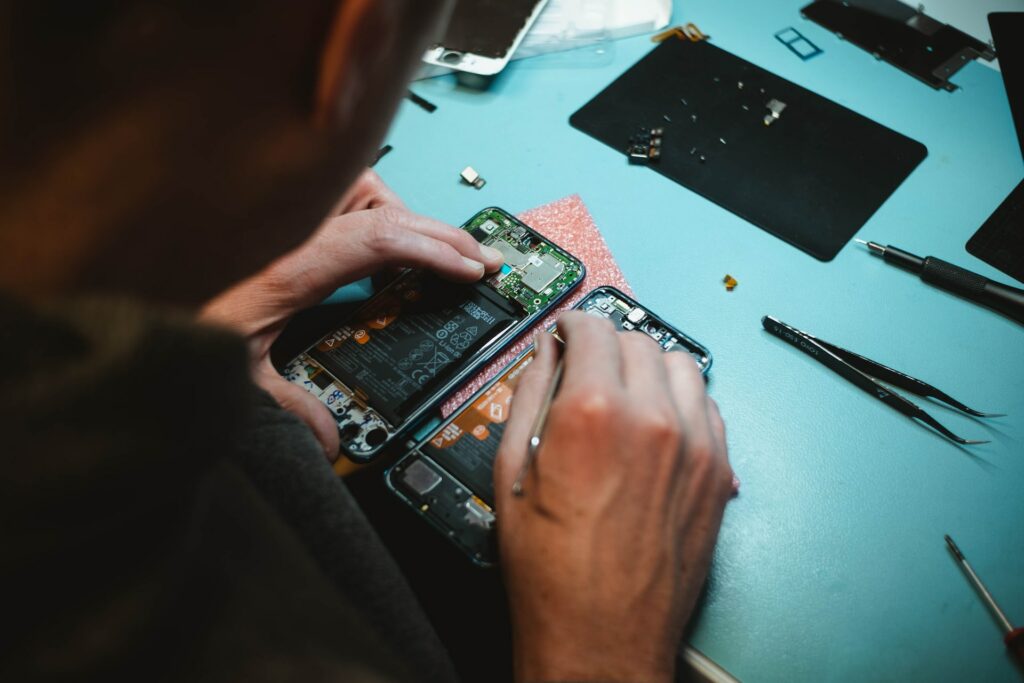Without a doubt, mobile phones and laptops are two of the most commonly used devices today. These gadgets have revolutionized how we communicate and work, making them indispensable tools in our daily lives. We rely on these essential gadgets that we rely on for both personal and professional purposes. They are designed to be efficient, user-friendly, and durable. However, like all electronic devices, they are prone to damage and malfunctioning. When that happens, repair becomes necessary. But are mobile phone repairs harder than laptop repairs? In this article, we will discuss the different factors that affect the reparability of these devices and find out which one is harder to fix.
Components and Features of Smartphones and Laptops

The build of mobile phones and laptops is an important factor in determining the reparability of these devices. Both devices have complex internal structures that house different components. Understanding these components can help when diagnosing and repairing issues.
Components and Features of a Phone
Let’s take a look at the build of mobile phones. Mobile phones are made of several components that work together to provide various functionalities. The primary parts of a mobile phone include the motherboard, battery, display, camera, speaker, microphone, and buttons. The motherboard is the central circuit board that connects all the components of a phone. The battery provides power to the device, while the display, camera, speaker, and microphone are responsible for providing audio-visual feedback to the user. The buttons, on the other hand, help in navigating the device’s interface and carrying out various functions.
Components and Features of a Laptop
In contrast, the build of laptops is more complex due to their larger size and higher processing power. Laptops have a more modular design, allowing for easy replacement and upgrade of components. The primary parts of a laptop include the motherboard, processor, memory, storage, display, keyboard, touchpad, and battery. The motherboard is the central hub that connects all the other components, including the processor, memory, and graphics card. The display provides visual feedback to the user, while the keyboard and touchpad help with data. The battery, in contrast, provides power to the device and allows for portability.
The design of phones makes them harder to disassemble and repair, while the modular design of laptops makes them more accessible.
Factors that influence phone and laptop repair

The Importance of Size in Repair
Size does matter when looking at the reparability of gadgets and electronics. Mobile phones and laptops vary significantly in size, with mobile phones being smaller and more compact than laptops. This difference in size is an essential factor to consider. Mobile phones are smaller, making them harder to disassemble and repair. Mobile phone manufacturers often use proprietary screws and adhesives to secure their devices, making them harder to open without causing damage. The implication is that even simple repairs, like replacing a cracked screen, can become more complicated and time-consuming.
Laptops are larger and more accessible, with standard screws and modular components that make them easier to repair. Laptops are also less likely to have proprietary components. What this means is that replacement parts are generally more widely available. However, the larger size of laptops makes them more complex to diagnose and repair due to their multiple subsystems. The sheer number of components in a laptop makes it challenging to determine the source of the problem, and some components may require specialized tools to repair or replace.
Despite these differences, mobile phones and laptops have reparability scores that consider the ease of disassembly, availability of replacement parts, and access to repair manuals. While mobile phones tend to have lower reparability scores than laptops, this does not necessarily mean that repairing a laptop is always easier or more cost-effective. Essentially, the decision to repair a device depends on several factors, including the device’s size, complexity, and reparability score, as well as the cost of replacement parts and the skills of the individual attempting the repair. While mobile phone repair may be more challenging due to the smaller size, it is still possible to repair them with the right tools and expertise.
Fasteners in Phones and Laptops
In mobile phones, manufacturers often use proprietary screws and adhesives to secure the device’s components, making it challenging to open the device without causing damage. This adds an extra layer of complexity to the repair process and makes it more difficult for individuals attempting DIY repairs.
Laptops tend to use standard screws that can be removed with commonly available tools. Because of this, it is simpler to disassemble and repair laptops, especially when compared to mobile phones. Although laptops may still use some adhesives to hold components in place, these are generally less challenging to work with than the adhesive used in mobile phones.
Repair Tools and Equipment
To repair any gadget, you need the right tools and equipment. Mobile phones often require specialized tools like suction cups, prying tools, and tri-wing screwdrivers. These tools are used to pry open the casing of the device without damaging the delicate components inside. They are practical for mobile phone repairs, where adhesive usually secures the device’s parts. Laptops require standard screwdrivers, spudgers, and anti-static mats. Investing in high-quality tools can make a difference in the repair process, making it easier and less risky.
It is crucial to have the necessary tools and equipment before you start with DIY repairs. Otherwise, you risk causing further damage to the device or injuring yourself. If you’re uncertain about what tools you need, consult online repair guides or seek advice from professional repair technicians.
The Complexity of Parts
Another significant factor that affects the reparability of mobile phones and laptops is the complexity of their components. Mobile phones have smaller and more intricate parts, making them challenging to repair. Smartphones are designed to be thin and lightweight, meaning that manufacturers use proprietary screws and adhesives to secure their devices. Moreover, mobile phones often have multiple subsystems that are integrated with the mainboard, making it harder to diagnose and fix a problem with one specific component.
The components in laptops are much larger and replaceable. Laptops are built to be functional and versatile, and manufacturers typically prioritize ease of repair. As a result, laptops often have standardized screws and modular components that can be removed and replaced.
Comparing Repair Costs: Smartphones vs Laptops
Repair costs can vary widely depending on the nature of the repair, the type of device, and the availability of replacement parts. It is necessary to note that repair costs for mobile phones can be higher than for laptops due to their smaller size and more intricate design. The compact design of mobile phones means that individual components may be harder to replace, leading to higher costs. However, some mobile phone manufacturers offer more affordable repair options, such as screen replacements, which can be done for a fraction of the cost of a new device.
Laptops, in contrast, tend to have more modular designs, making them cheaper to repair. Common laptop repairs, such as replacing a broken screen or keyboard, can be done relatively quickly and at a reasonable cost. However, repairs for more complex issues, such as motherboard damage, can be more expensive, as specialized knowledge and tools are required.
It is also essential to weigh them against the cost of replacing the device when considering repair costs. If the repair cost is close to or exceeds the cost of a new device, then it may be more cost-effective to replace the device. However, if the repair cost is significantly lower than the cost of a new device, then repairing the device may be the more sensible option. In the next section, we will look at the software issues between smartphones and laptops.
Software Differences: Smartphones vs Laptops
While physical damage is a common reason for device repair, software issues can also cause problems. Mobile phones and laptops are complex devices that run on software, and issues can arise when the software is outdated, corrupted, or infected with malware.
Software issues can be quite tricky to diagnose. Unlike physical damage that is often visible, software problems may not be immediately apparent. It could take several attempts to troubleshoot the problem before it can be identified. Software issues can cause a range of problems, from slow performance to system crashes, making it even more challenging to pinpoint the root cause of the problem. In mobile phones, software updates can often solve software issues, but if the problem is more severe, a factory reset may be necessary. However, a factory reset erases all data on the device, so it’s important to back up all important data before performing the reset. In some cases, professional repair may be necessary to fix software issues in mobile phones, especially if the problem is caused by malware or other viruses.
In laptops, software issues can be more complex due to the multiple subsystems and programs that run on them. The operating system, drivers, and applications can all cause problems, and diagnosing and repairing them can be time-consuming. Some software issues can be solved by performing a system restore or reinstalling the operating system, but this also erases all data on the device. It’s essential to back up all data before attempting any repairs. Manufacturers also have a role to play in the repair of these devices, and that is what we will look at in the next section.
The Role of Manufacturers of Phones and Laptops
Manufacturers play a significant role in the reparability of mobile phones and laptops. They determine the design and composition of the devices, including the availability of replacement parts and repair manuals. As per a report from The Verge, Apple, Microsoft, and Google laptops and smartphones are significantly less easy to repair compared to Asus, Dell, and Motorola devices, which are made by their competitors.
The design choices made by manufacturers can impact the ease of repair and the availability of replacement parts. Also, manufacturers only offer replacement parts to authorized repair centers, making it difficult for independent repair shops or DIY repairers to access them. This not only limits consumer choice but also increases the cost of repairs.
Recently, there has been a push for a “right to repair” legislation. This movement seeks to provide consumers and independent repair shops with access to repair manuals, replacement parts, and diagnostic tools that are typically available only to manufacturers and authorized repair centers. The push for right to repair legislation has gained momentum in response to the increasing complexity and proprietary design of modern electronic devices, which can make repair more challenging and costly.
Frequently Asked Questions on Phone and Laptop Repairs
Mobile phones are usually harder to repair than laptops because of their smaller size and compactness. They have many components and connections that are integrated into the design. Additionally, many mobile phone manufacturers use proprietary components and adhesive materials that can make it more challenging to access and replace parts.
Yes, it is possible to repair your mobile phone or laptop yourself, but it’s important to have the necessary skills and tools. For more complex repairs, it may be better to seek the help of a professional repair technician.
The decision to repair or replace your mobile phone or laptop depends on the extent of the damage, the cost of repairs, and the age and condition of the device. In some cases, it may be more cost-effective to repair your device, while in other cases it may be more practical to replace it.
Right to repair legislation is a movement to require manufacturers to make repair manuals and replacement parts available to consumers and independent repair shops. This can make it easier and more cost-effective to repair mobile phones and laptops, as consumers and independent repair shops can access the necessary resources to repair devices.
Yes, it is possible to recycle your mobile phone or laptop if you can’t repair it. Many manufacturers and retailers offer recycling programs that allow you to safely dispose of your electronic devices and reduce electronic waste.
Conclusion: Are mobile phones repair harder than laptops repair?
While laptops tend to have higher reparability scores and be easier to repair due to their larger size and modular components, mobile phones can be more challenging to repair due to their compact size and proprietary design.
However, whether you opt for DIY repair or professional repair, it’s crucial to carefully consider the trade-offs involved. DIY repair can be more cost-effective, but it’s vital to have the required skills and tools. Professional repair offers a higher level of expertise, although it can be more expensive.
Ultimately, the choice to repair or replace a device depends on individual needs and priorities. It’s worth of note to balance the cost, difficulty of repair, and availability of replacement parts when making this decision. By doing so, you can ensure that you make the best choice for both your wallet and the environment.

